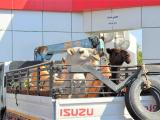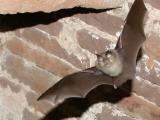The most thorough survey yet of Middle East respiratory syndrome coronavirus (MERS-CoV) in Saudi Arabia's camel population shows that the virus is found in camels throughout the country and that it or a closely related virus has probably circulated in the animals since at least 1992, according to a report released today in mBio.
The study adds to the already considerable evidence suggesting that camels are a source of human MERS infections, but it doesn't prove it, says the report by a Saudi-US team of researchers.
The findings also raise the question whether the virus was circulating silently in humans for years before the first cases were detected in 2012, the authors say.
The researchers collected blood, nasal, and rectal samples from camels around Saudi Arabia last year and found that 74% of them carried antibodies to MERS-CoV. Further, they found pieces of the virus itself in 35% of young camels and 15% of adult camels. Testing of preserved camel serum samples revealed antibodies to the virus in samples dating back to 1992.
"Adult camels were more likely to have antibodies to the virus while juveniles were more likely to have active virus," W. Ian Lipkin, MD, senior author of the study, commented in a press release from the American Society for Microbiology, publisher of mBio. "This indicates that infection in camels typically occurs in early life, and that if people get the virus from camels the most likely source is young camels."
The suspicion that dromedary camels may pass MERS-CoV to humans has been building for months. Multiple serologic studies have pointed to MERS-CoV–like antibodies in camels in several countries, including Oman, Egypt, the Canary Islands, Jordan, Saudi Arabia, and the United Arab Emirates.
In mid-December, scientists found that three camels on a Qatari farm were infected with MERS-CoV strains very similar to those in two people who owned and worked at the farm. But they couldn't discern if the camels had passed the virus to the people or vice versa, or if both hosts acquired it from some other source.
Bats are also suspected as a reservoir of the virus because they harbor related coronaviruses. In 2013, Lipkin's team reported finding a virus fragment that suggested MERS-CoV in a bat fecal sample from a site near the home of the first Saudi Arabian infected with the virus, but the finding was not regarded as conclusive. The new report notes that the Saudi Arabian patient owned four pet camels.
Nationwide survey
The scientists collected samples from 203 camels in five regions of Saudi Arabia in November and December of 2013 and analyzed 264 archived samples collected from 1992 through 2010.
In the serologic study, 150 of 203 camels sampled in 2013 had MERS-CoV antibodies. Antibodies were significantly more common in adult camels (older than 2 years) than in younger camels: 93 of 98 (95%) versus 57 of 104 (55%).
In the archived samples, the prevalence of antibodies to MERS-CoV (or a MERS-CoV-like virus) ranged from 72% to 100%. As in the 2013 specimens, antibodies were more common in adult camels than in calves. The prevalence of reactivity was high even in the oldest samples: for example, 2 of 2 samples from 1993 and 114 of 123 from 1994.
The results from the archived samples "strongly suggest that MERS-CoV or a closely related virus has been circulating in DC [dromedary camels] in the KSA [Kingdom of Saudi Arabia] for at least two decades," the authors write.
The team used reverse transcription–quantitative polymerase chain reaction (RT-qPCR) to look for two segments of the MERS-CoV genome in nasal and rectal swabs from the camels. Pieces of the virus were found significantly more often in young camels than in adults: 36 of 194 (35%) versus 15 of 98 (15%). The five samples with the most viral material all came from juvenile camels.
Viral fragments were found mainly in the nasal samples; only three rectal specimens tested positive. No virus was found in blood from a random selection of camels whose nasal or rectal samples had tested positive. These findings suggest, the authors say, that the virus most likely spreads by the airborne route.
The camels that tested positive for MERS-CoV sequences showed no signs of illness, according to Thomas Briese, PhD, of Columbia University, a co-author of the study. "The camels were regular animals; no overt disease signs were recorded," he told CIDRAP News.
The researchers also tested a number of goats and sheep for MERS-CoV antibodies and sequences. They found no evidence of MERS-CoV antibodies, though some of the animals had antibodies to bovine coronavirus, a relative of MERS-CoV. None of the goats or sheep tested positive by RT-qPCR.
Still no proof of link
The authors say their findings do not prove that camels are essential for fueling transmission of MERS-CoV in humans, but they do provide evidence that camels are "sufficient to maintain" the virus.
"The camels clearly have the virus, it's circulating there, so there is opportunity to infect," said Briese. "The question is, what is the pathway, how does it get to the humans. . . . That has to be investigated now." He observed that many humans who were infected did not have a history of contact with camels.
The scientists write that there are unpublished data showing that complete MERS-CoV genomic sequences from Saudi Arabian camels are identical to sequences from human patients. But what is still needed to establish that camels are passing the virus to humans is "rigorous epidemiologic investigation of the potential for exposure to DC in sporadic cases of MERS-CoV" (cases in humans who had no exposure to other MERS patients).
If a camel link in the outbreak is established, it will raise the question of whether the virus became a human pathogen only in 2012, when the first cases surfaced, or was circulating silently in humans well before then, the scientists write. They say it may be possible to address this question by studying archived human samples.
If no evidence of human infection before 2012 can be found, it would suggest the possibility that a mutation in the virus facilitated its jump from camels (or other animals) to humans, they add. But to test that hypothesis would require testing historical camel respiratory tract samples, which the scientists said they have been unable to find.
Another research avenue is to look further at other animals, said Briese. "What's still open is looking at other potential animal species that could link or transfer the virus," he said. He mentioned rodents, cats, and dogs as some animals to consider, given their contact with humans.
Welcome findings, persistent questions
Other experts welcomed the findings but agreed that key questions about the role of camels remain.
"I think this study shows definitively that MERS-CoV is a camel virus," Marion Koopmans, DVM, PhD, told CIDRAP News. Koopmans is head of virology at the Laboratory for Infectious Diseases of the National Institute of Public Health and the Environment in the Netherlands.
"What is still unclear is how people get infected, if it is directly through animal contact, via environmental contamination, or some unknown other source. For that the detailed studies, planned in collaboration with WHO, are needed," she added.
Michael T. Osterholm, PhD, MPH, called the study "very well done," and added that a key question now is whether the virus that's circulating today is the same one that was in camels 20 years ago. He is director of the University of Minnesota's Center for Infectious Disease Research and Policy, publisher of CIDRAP News.
He said research is needed on the possibility that MERS-CoV was circulating under the radar in humans before 2012, but there's no evidence of that so far.
If there were no human cases before 2012, it points in the direction of a recent mutation that equipped the virus to infect humans, Osterholm commented. "There's some event that's resulted in transmission from animals to humans," he said.
Alagaili AN, Briese T, Mishra N, et al. Middle East Respiratory Syndrome Coronavirus Infection in Dromedary Camels in Saudi Arabia. mBio 2014 Feb 25 (Early online publication) [Abstract]
See also:
Feb 25 ASM press release
Jan 30 CIDRAP News item on evidence of MERS-CoV in UAE camels in 2005
Jan 3 CIDRAP News story on evidence of MERS CoV in UAE camels in 2003
Dec 16, 2013, CIDRAP News story on detection of MERS-CoV in camels on Qatar farm linked to human cases





















